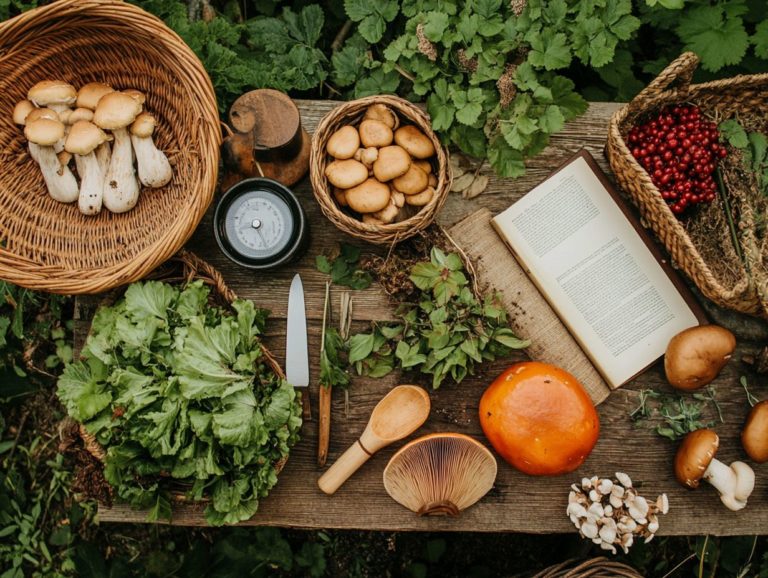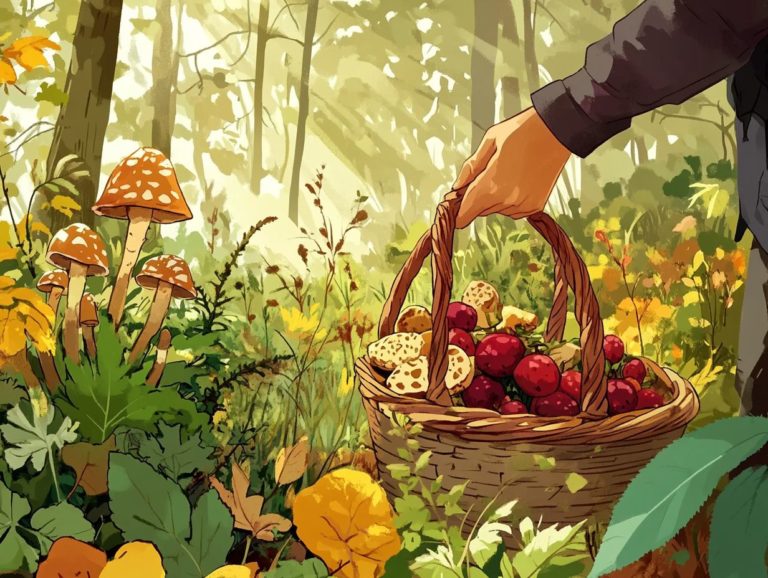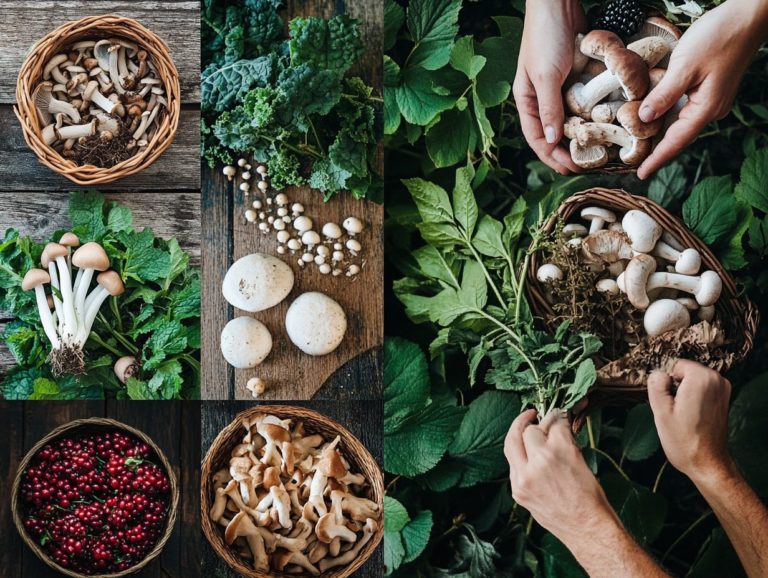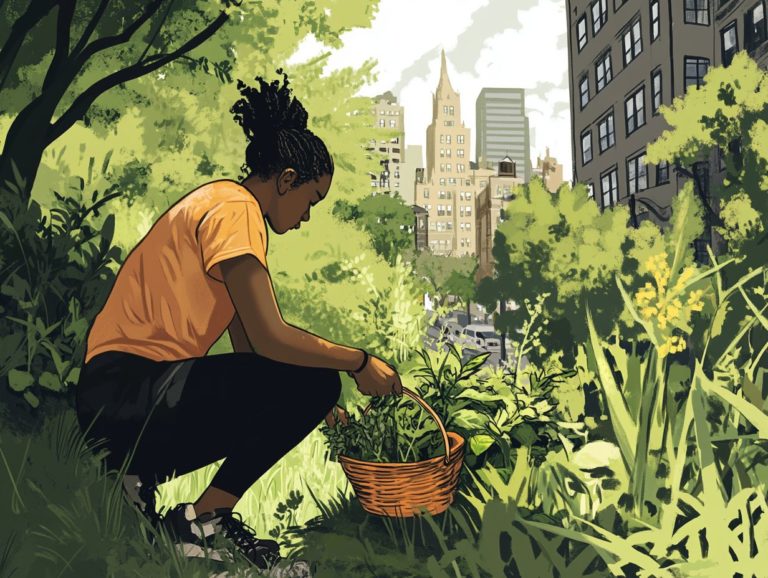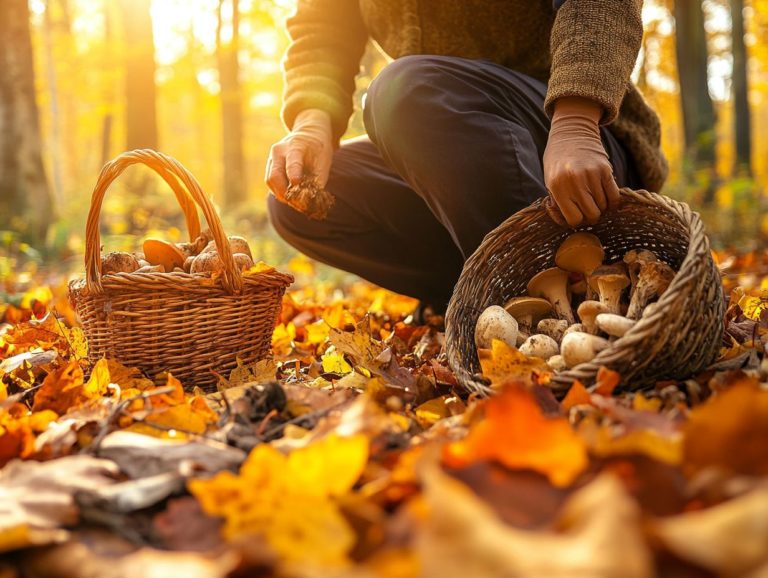Autumn Harvest: What Wild Veggies to Collect
As autumn unfolds, nature’s bounty offers you an exhilarating opportunity to uncover a treasure trove of wild vegetables.
This article explores the many benefits of foraging. From enriching your diet with nutritious foods to promoting environmental sustainability, foraging is a rewarding activity.
You’ll find guidance on identifying common wild veggies, along with essential tools and techniques to begin your foraging adventure. You ll also get tips on cleaning and cooking your finds to elevate your culinary experience.
Important safety considerations are addressed to ensure your journey is both enjoyable and rewarding. Join the adventure of the autumn harvest and discover your next favorite wild veggie!
Contents
Key Takeaways:
- Foraging for wild veggies during autumn provides many nutritional and environmental benefits.
- Identifying and collecting veggies safely requires the right tools and methods.
- Cleaning and cooking wild veggies properly ensures safety and enhances taste.
Understanding Autumn Harvest
Autumn harvest refers to collecting crops that are ready for gathering as winter approaches. This includes cool-weather crops and nutritious vegetables. For those interested in foraging, finding wild herbs can also enhance your gardening experience and is a crucial aspect that helps the environment.
By understanding the timing and preparation involved in the autumn harvest, you can maximize your yield and enjoy a sustained bounty. Don’t forget to explore harvesting wild grains and incorporate seasonal delights like kale, broccoli, and root vegetables!
This period is essential not just for the delicious produce but also for the impressive health benefits these crops provide. Many of these vegetables are brimming with vitamins A and C, fiber, and antioxidants, all contributing to a balanced diet during the colder months.
Using effective harvesting techniques like employing sharp tools to avoid damage and picking at the right times of day ensures that your crops retain their freshness and flavor. Thoughtful planning of your garden layout can facilitate crop rotation and enhance soil health, setting you up for success in future planting seasons.
Benefits of Foraging for Wild Veggies
Foraging for wild veggies offers many benefits, from boosting your nutritional intake to providing substantial environmental advantages. It s an enriching practice for anyone eager to diversify their diet and connect with nature.
By exploring local flora, you can uncover a range of leafy greens and other nutritious vegetables that thrive in the wild. This not only promotes sustainable practices but also deepens your bond with the natural world around you.
Nutritional and Environmental Benefits
Wild veggies are packed with nutrients, offering a rich array of vitamins and minerals that often outshine those found in conventionally grown crops. Their environmental advantages significantly contribute to biodiversity and ecological balance.
When consuming foraged vegetables like kale and arugula, you re enhancing your personal health while supporting sustainable practices that nurture the planet.
These wild greens are typically loaded with essential nutrients such as vitamin C, vitamin A, and various antioxidants, all crucial for boosting your immune function and overall well-being. Choosing to include these foraged treasures in your diet helps preserve local ecosystems. These hardy plants thrive in their natural habitats without the need for synthetic fertilizers or pesticides.
This choice not only helps reduce your carbon footprint but also promotes healthy soil, vital for sustaining diverse plant and animal life. Embracing wild greens becomes both a personal and collective step toward achieving a more balanced and environmentally friendly lifestyle.
Get outside this autumn and start your foraging journey today!
Identifying and Collecting Wild Veggies
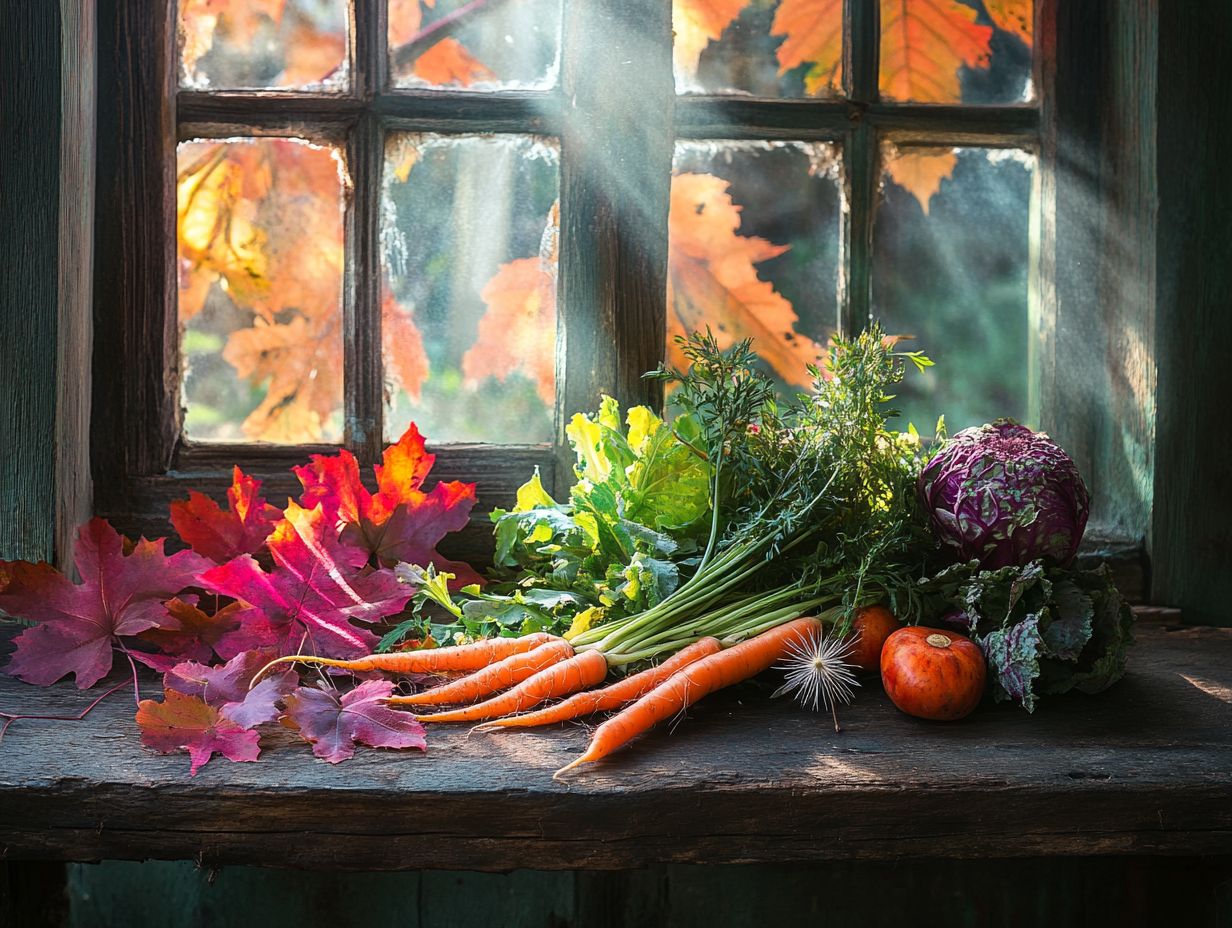
Successfully identifying and collecting wild veggies demands careful observation and a solid understanding of local flora. You can develop this understanding through various foraging techniques and guides, such as those for edible fungi in fall.
By familiarizing yourself with edible plants like garlic, radishes, and Swiss chard, you can confidently gather nutritious ingredients while prioritizing safety and sustainability.
Common Types of Wild Veggies
Common types of wild veggies present a delightful assortment of edible plants, such as dandelion greens, wild garlic, and arugula. For those interested in foraging, exploring spring wildflowers: edibles you can forage can reveal even more unique flavor profiles and impressive nutritional benefits.
Discover these leafy greens and root vegetables thriving in both urban and rural areas, and check out fruit picking season for an exciting foraging adventure!
Take dandelion greens, for example. They are often hailed as a superfood and are brimming with vitamins A, C, and K. They can easily be tossed into salads or saut ed for a nutritious side dish.
Wild garlic, with its bold and pungent flavor, can transform your pesto or soups. Meanwhile, arugula brings a delightful peppery bite to salads and sandwiches.
Other enticing options include:
- Lamb’s quarters, which bear a striking resemblance to spinach and are rich in nutrients.
- Purslane, celebrated for its juicy leaves and omega-3 fatty acids.
For those eager to forage, it’s crucial to accurately identify these plants and ensure they are harvested from areas free of pollution or chemicals.
Tools and Techniques for Foraging
Equipping yourself with the right tools and techniques for foraging is crucial for successfully identifying and collecting wild veggies. For more insights, check out seasonal edibles for foraging in spring, ensuring your experience in nature is both safe and rewarding.
Basic essentials like a foraging basket, a sharp knife, and a reliable field guide can dramatically enhance your efficiency. A sturdy pair of gloves protects your hands from prickly foliage and potential irritants as you navigate through areas thick with wild edibles.
Another handy tool is a trowel, perfect for gently digging up roots and bulbs, which adds delightful variety to your foraged collections. Consider carrying a small notebook for jotting down observations about locations and seasons, helping you track the optimal times for harvesting specific species.
By mastering effective techniques such as mindful harvesting, which means taking only what you need and leaving plenty for nature to thrive, and proper identification you cultivate a respectful relationship with nature. This yields not just a bountiful harvest but also a deeper appreciation for the wild environment around you.
Preparing and Cooking Wild Veggies
Preparing and cooking wild vegetables calls for a keen understanding of proper cleaning techniques and culinary applications. This approach allows you to fully appreciate their distinctive flavors and nutritional benefits.
By employing straightforward cleaning tips, you can ensure that vegetables like wild spinach and broccoli are free from contaminants. This makes them perfect for delightful dishes that truly celebrate their natural sweetness.
Now that you re equipped with knowledge and tools, it s time to step outside and discover the delicious wild veggies waiting for you!
Cleaning and Cooking Tips
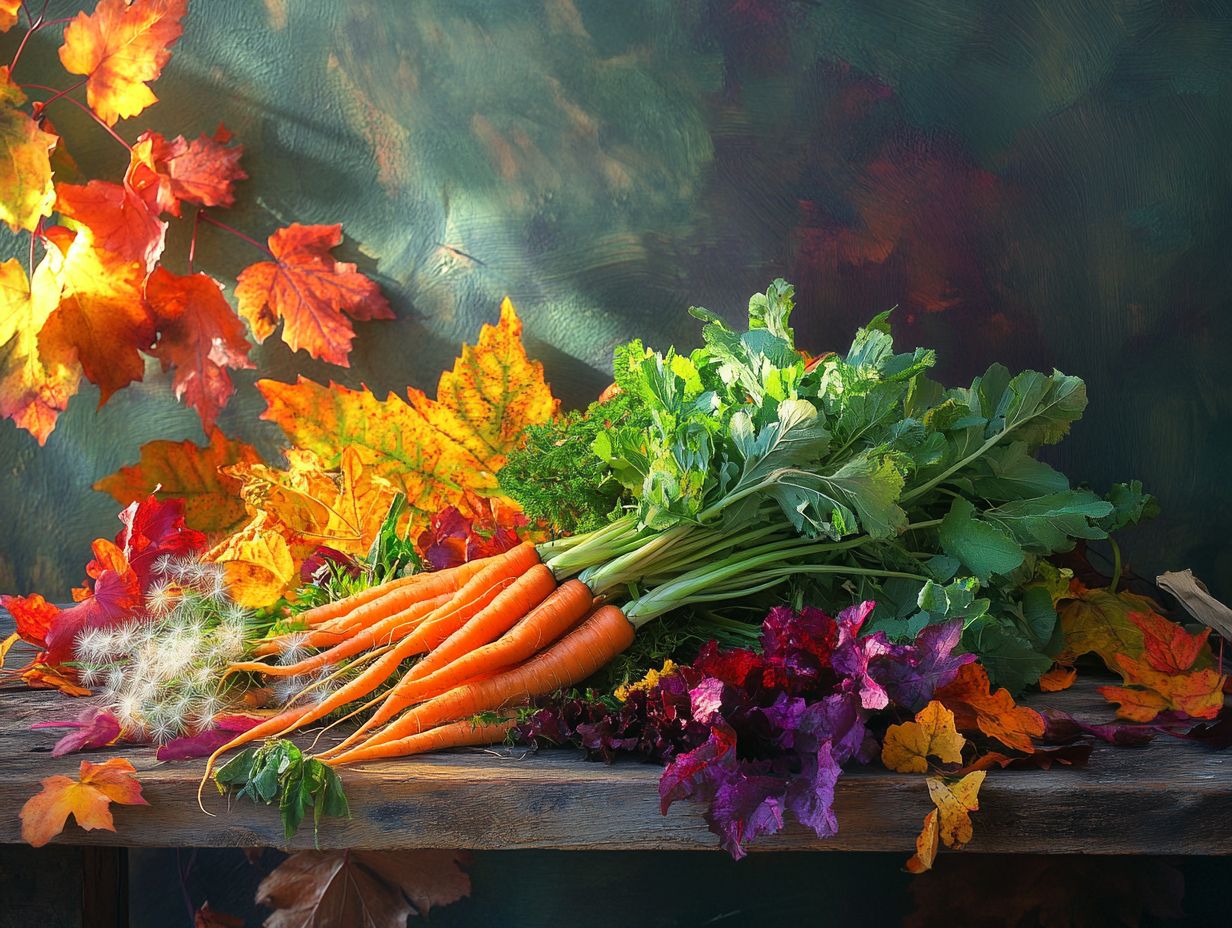
Cleaning and cooking your wild veggies involves a few essential steps that ensure both safety and flavor, transforming them into an exciting addition to any meal. Start by thoroughly rinsing vegetables like wild leeks and radishes to eliminate dirt.
Then, opt for cooking methods such as saut ing or steaming to truly bring out their delicious, sweet flavors. It s important to identify these wild edibles correctly, as some look-alikes can make you sick.
For example, when you’re preparing wild greens like lamb’s quarters or purslane, take the time to remove any tough stems and damaged leaves. This will significantly enhance both the texture and taste.
To elevate your experience, think about marinating these veggies briefly before cooking. A blend of olive oil, lemon juice, or garlic can beautifully enhance their natural character.
When you saut , a quick cook over medium heat allows the veggies to retain their vibrant color and nutrients. Steaming helps lock in moisture, ensuring that each bite is both flavorful and nourishing.
Safety Considerations for Foraging
When foraging, safety should always be your top priority. Misidentifying plants can lead to poisoning. Learn to identify plants correctly to stay safe!
Invest time in learning how to identify edible plants accurately. Consulting trustworthy sources or connecting with experienced foragers will enhance your knowledge and ensure a safe experience in the great outdoors.
Potential Risks and How to Avoid Them
Foraging carries potential risks, including allergic reactions, misidentifying edible plants, and encountering environmental hazards. This highlights the necessity of proper education and preparation.
Use reliable field guides and forage with experienced friends. Get to know your local flora and fauna, as some edible plants have poisonous doppelgangers.
Engaging in workshops or guided foraging trips can significantly enhance your skills in plant identification. You ll gain invaluable firsthand experience in distinguishing the safe from the unsafe.
Be aware of your surroundings; exercise caution concerning pesticides and pollution in areas where wild plants thrive. Keeping a journal of your findings can also be beneficial. Document safe plants and locations for future reference, making the experience enjoyable and secure.
Frequently Asked Questions
What is an Autumn Harvest?
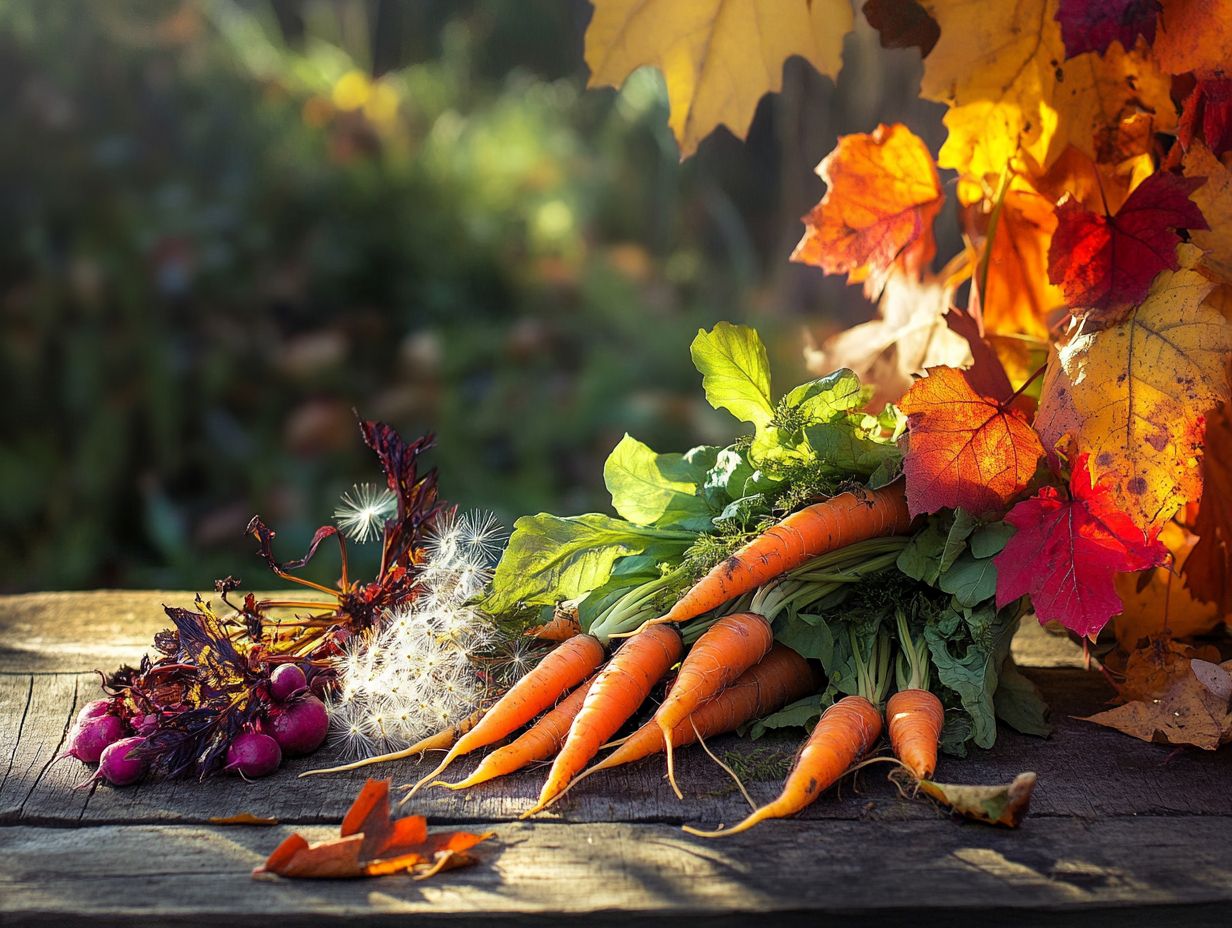
An Autumn Harvest is the gathering of crops and produce during the autumn season, typically around September to November. This can include fall vegetables such as kale, broccoli, and root vegetables, as well as wild edibles to forage in winter.
What are Wild Veggies?
Wild Veggies are plants that grow naturally without human cultivation or intervention.
What are some Wild Veggies that can be collected during Autumn Harvest?
- Mushrooms
- Wild greens (like dandelion and chicory)
- Nuts (like chestnuts and acorns)
How can I identify if a Wild Veggie is safe to collect?
It is important to properly identify Wild Veggies before collecting them. To assist you, refer to a reliable foraging guide or consult with a knowledgeable expert. You can also check out what to harvest: seasonal foraging checklist to ensure the safety and edibility of the plant.
Can I collect Wild Veggies from any location?
No, it is important to only collect Wild Veggies from locations that are safe and legal to forage. Avoid picking from contaminated areas or private property without permission.
What are some ways to use wild vegetables collected during the autumn harvest?
Wild vegetables collected during the autumn harvest can be used in many dishes.
Try adding them to salads, soups, stir-fries, or even pickling them for future use. Get creative and experiment with different recipes!

